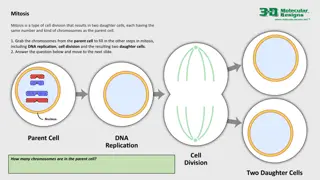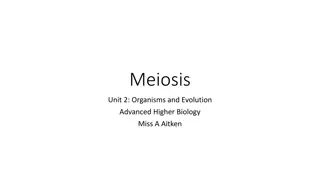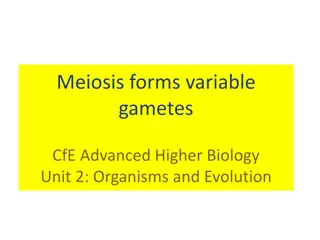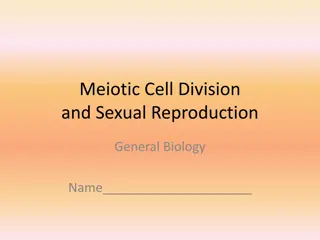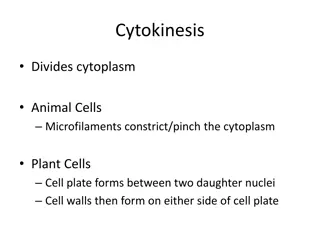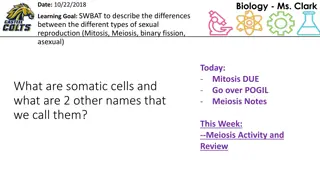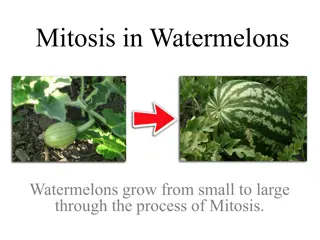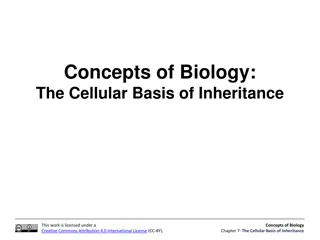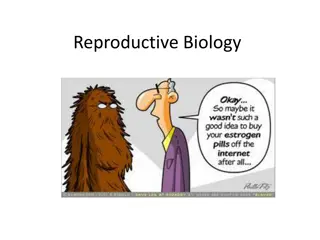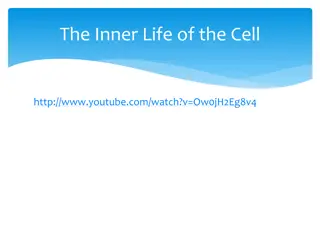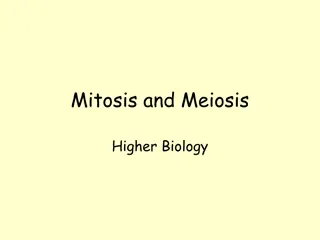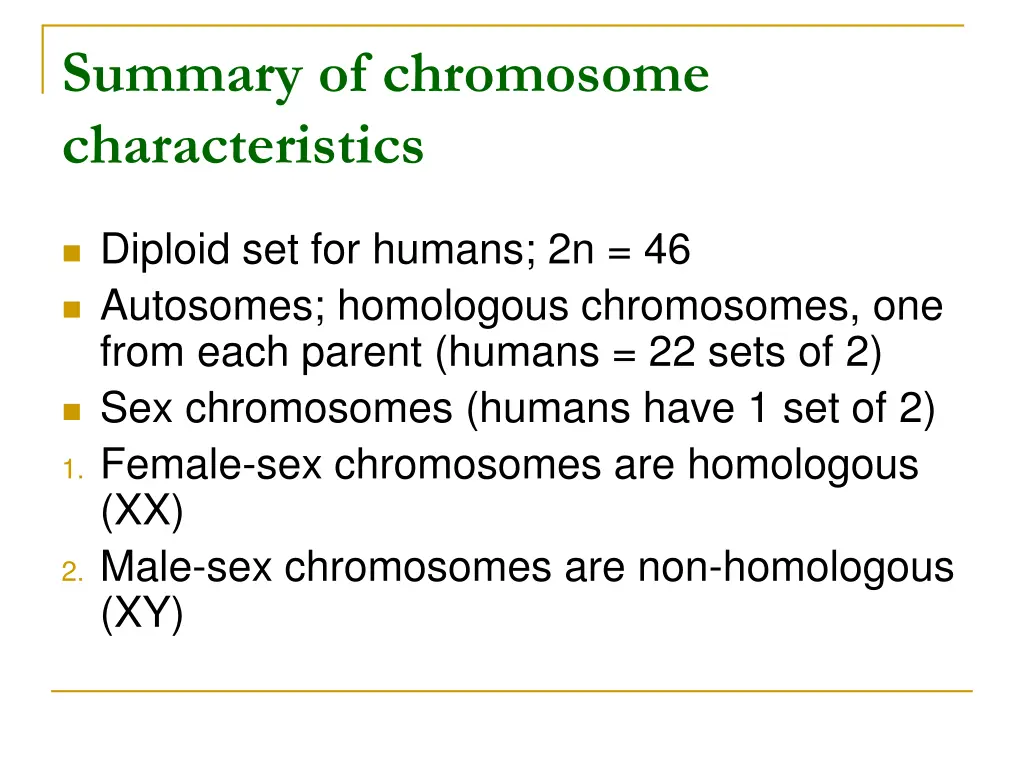
Understanding Human Chromosome Characteristics and Meiosis Process
Delve into the intriguing world of human chromosome characteristics and the essential process of meiosis, shedding light on the distinction between haploid and diploid cells, the significance of sexual reproduction, and the critical role of meiosis in maintaining genetic diversity.
Download Presentation

Please find below an Image/Link to download the presentation.
The content on the website is provided AS IS for your information and personal use only. It may not be sold, licensed, or shared on other websites without obtaining consent from the author. If you encounter any issues during the download, it is possible that the publisher has removed the file from their server.
You are allowed to download the files provided on this website for personal or commercial use, subject to the condition that they are used lawfully. All files are the property of their respective owners.
The content on the website is provided AS IS for your information and personal use only. It may not be sold, licensed, or shared on other websites without obtaining consent from the author.
E N D
Presentation Transcript
Summary of chromosome characteristics Diploid set for humans; 2n = 46 Autosomes; homologous chromosomes, one from each parent (humans = 22 sets of 2) Sex chromosomes (humans have 1 set of 2) 1. Female-sex chromosomes are homologous (XX) 2. Male-sex chromosomes are non-homologous (XY)
Most plant and animal adults are diploid (2n) Eggs and sperm are haploid (n)
Meiosis Meiosis has some similarities to mitosis Meiosis has some very important differences too! During meiosis and the cytokinesis that follow, one diploid mother cell (2n) makes four unique daughter cells and they are all haploid (1n)!
Meiosis Meiosis is often called "reduction division" because the genetic material is reduced - by half. Meiosis is extremely important not only for sexual reproduction, but also for creating the diversity upon which natural selection operates.
Sexual reproduction Combines the genetic information from two different cells that are usually from two different individuals. Each parent contributes a haploid (n) gamete (sex cell). These two gametes, a female egg and a male sperm, fuse to produce a genetically unique single cell called a zygote.
The zygote is diploid (2n) having combined the genetic information provided by the gametes (n) of both parents. In a very real genetic sense, all offspring of sexual reproduction are "half identical" to each parent!
If it were not for meiosis, sexual reproduction would double chromosome sets every generation! That's deadly and that's why meiosis is important.
That new individual will be diploid having been created by the fusion of two haploid (n) cells. It goes from generation to generation. Our genetic material has been handed down in "half loads" (haploid gametes = n) from our ancestors and fused into "full loads" (diploid zygotes = 2n).
Each individual is unique but is also a mix. We are "half like" ( ) each of our (two) parents, a "quarter like" ( ) each of our (four) grandparents, an "eight like" (1/8) each of our (eight) great grandparents, a "sixteenth like" (1/16) each of our (sixteen) great, great grandparents, etc.
But meiosis is not "simply" a halving of the genetic materials. Chromosomes have to be distributed in a precise manner to make sure that a full set (n) of chromosomes is in the gametes.
Meiosis has three purposes: 1St: reduction of the chromosomes' number from diploid (2n) to haploid (n). 2nd: ensure the haploids are composed of a complete set of chromosomes. 3rd promote genetic diversity among the products (gametes).
The "trick" to meiosis is to understand that the DNA is replicated only once, during S phase in interphase, BUT the nucleus divides TWICE! It is also important to understand that a diploid cell, containing its normal 2n complement of chromosomes, is composed of a set (n) from each parent and they can be thought of as pairs of chromosomes.
What is meiosis I? In meiosis I, chromosomes in a diploid cell resegregate, producing four haploid daughter cells. It is this step in meiosis that generates genetic diversity. The phases of meiosis I & II
Prophase I DNA replication precedes the start of meiosis I. During prophase I, homologous chromosomes pair and form synapses, a step unique to meiosis.
Prophase I The paired chromosomes are called tetrads. Here genetic recombination can occur by a process called crossing over.
Prophase I Chromosomal condensation allows these to be viewed in the microscope. Tetrads have two chromosomes and four chromatids, One chromosome coming from each parent.
Late Prophase I/Prometaphase I The nuclear membrane disappears. The chromosomes attached to spindle fibers begin to move.
Metaphase I Tetrads, each composed of two chromosomes (four chromatids) align at the metaphase plate. The orientation is random, with either parental homologue on a side.
Metaphase I This means that there is a 50-50 chance for the daughter cells to get either the mother's or father's homologue for each chromosome.
Anaphase I Tetrads separate. Chromosomes, each with two chromatids, move to separate poles. Each of the daughter cells is now haploid (23 chromosomes), but each chromosome has two chromatids.
Telophase I Nuclear envelopes may reform, or the cell may quickly start meiosis II.
Cytokinesis Analogous to mitosis where two complete daughter cells form.
Meiosis II Meiosis II is similar to mitosis. However, there is no "S" phase. The chromatids of each chromosome are no longer identical because of recombination. Meiosis II separates the chromatids producing two daughter cells each with 23 chromosomes (haploid), and each chromosome has only one chromatid.


